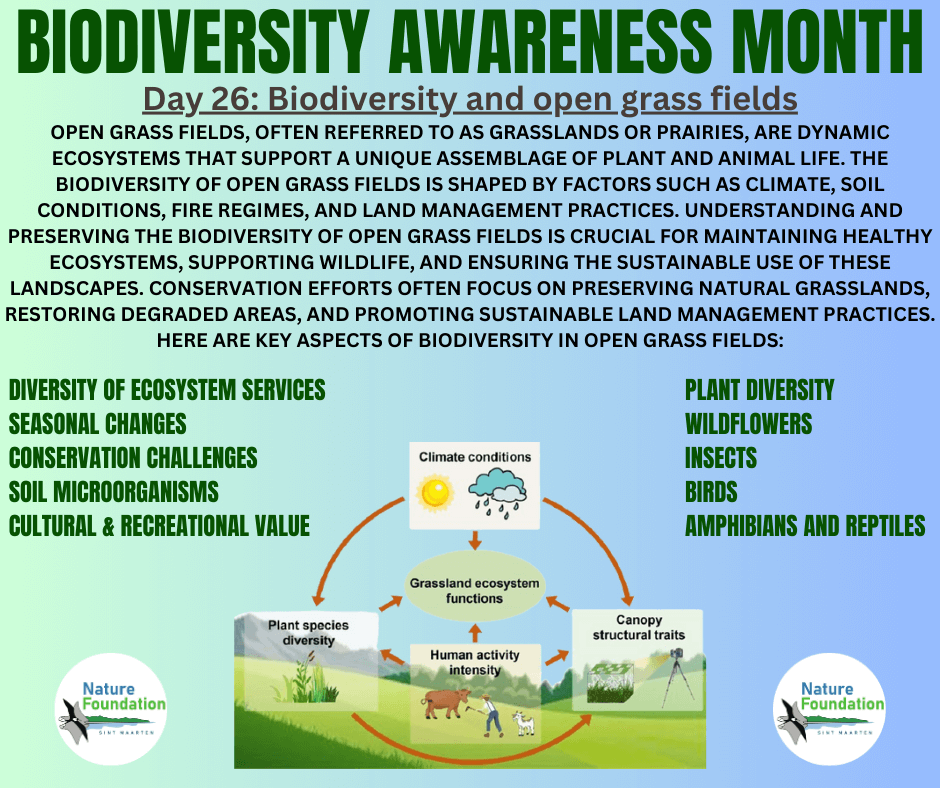Biodiversity month day 26: Biodiversity and open grass fields
The St. Maarten Hospitality & Trade Association supports the March Biodiversity awareness month organized by the Nature Foundation in an effort to help protect St. Maartens nature and biodiversity. Todays topic: Biodiversity and open grass fields
Open grass fields, often referred to as grasslands or prairies, are dynamic ecosystems that support a unique assemblage of plant and animal life. The biodiversity of open grass fields is shaped by factors such as climate, soil conditions, fire regimes, and land management practices. Here are key aspects of biodiversity in open grass fields:
1. Plant Diversity:
Grasses: Grass fields are dominated by various grass species, which may include both native and non-native varieties. Grasses are adapted to the open landscape and play a crucial role in nutrient cycling.
2. Wildflowers:
Grass fields can support a diverse array of wildflowers, each adapted to specific soil and climatic conditions. These plants provide food for herbivores and support pollinators.
3. Insects:
Grasslands are habitat for a rich diversity of insects, including butterflies, bees, grasshoppers, and beetles. These insects play essential roles in pollination, nutrient cycling, and forming the base of food webs.
4. Birds:
Grassland birds are adapted to the open landscape, utilizing it for nesting, foraging, and displaying courtship behaviors. Examples include meadowlarks, bobolinks, and various species of sparrows.
5. Amphibians and Reptiles:
Some grassland areas support amphibians and reptiles. Ponds, depressions, or areas with seasonal water may attract amphibians, while snakes and lizards can be found in grassy habitats.
6. Soil Microorganisms:
Grass fields host a variety of soil microorganisms that contribute to nutrient cycling and support plant health. Mycorrhizal fungi, for example, form symbiotic relationships with grasses and many other plants.
7. Diversity of Ecosystem Services:
Open grass fields provide various ecosystem services, including carbon sequestration, water filtration, and soil stabilization. Biodiversity contributes to the resilience and functionality of these services.
8. Seasonal Changes:
Grasslands may undergo seasonal changes in response to variations in temperature and precipitation. Some grasses may go dormant during dry periods and become lush with new growth during the wet season.
9. Invasive Species Threat:
Open grass fields may face threats from invasive plant species that outcompete native vegetation. Invasive plants can alter the structure of the grassland ecosystem and negatively impact native biodiversity.
10. Conservation Challenges:
Human activities, such as agriculture, urbanization, and overgrazing, can pose challenges to the conservation of open grass field biodiversity. Sustainable land management practices and conservation efforts are essential to address these challenges.
11. Cultural and Recreational Value:
Grass fields often hold cultural significance and provide recreational opportunities. They are valued for activities such as hiking, birdwatching, and photography.
Understanding and preserving the biodiversity of open grass fields is crucial for maintaining healthy ecosystems, supporting wildlife, and ensuring the sustainable use of these landscapes. Conservation efforts often focus on preserving natural grasslands, restoring degraded areas, and promoting sustainable land management practices.
Back to the Visit St Maarten Main page

